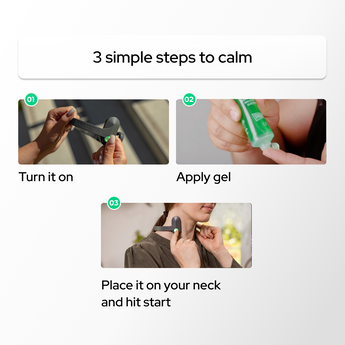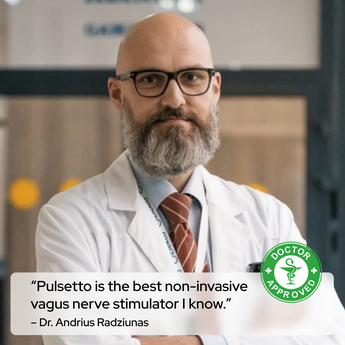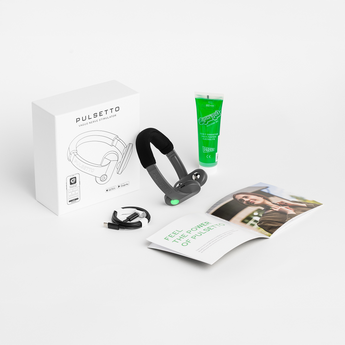Key Takeaways
- Vagus nerve stimulation (VNS) can help regulate blood pressure by activating the parasympathetic nervous system.
- Scientific studies support the effectiveness of VNS in managing blood pressure and enhancing heart rate variability.
- HRV exercises, such as deep breathing and cold showers, are effective natural methods to manage blood pressure.
- Non-invasive vagus nerve stimulator devices like Pulsetto provide an easy and efficient way to stimulate the vagus nerve and control blood pressure.
Vagus Nerve Stimulation and Blood Pressure
Blood pressure is the force of blood pushing against the walls of your arteries. When this pressure is too high, it can lead to serious health issues like heart disease and stroke. Common blood pressure disorders include hypertension (high blood pressure) and hypotension (low blood pressure).

A blood pressure reading of less than 120/80 mmHg is considered normal. This means the systolic pressure (the first number) is below 120 mmHg, and the diastolic pressure (the second number) is below 80 mmHg (image courtesy of American Heart Association).
Understanding the Vagus Nerve
The vagus nerve is a critical part of our body's nervous system. It extends from the brainstem to the abdomen and influences various bodily functions such as heart rate, digestion, and respiratory rate. This nerve is like a communication highway between the brain and internal organs, playing a significant role in the parasympathetic nervous system.

The vagus nerve.
When the vagus nerve is stimulated, it releases neurotransmitters that may help manage blood pressure and heart rate. This is why stimulating the vagus nerve can be beneficial for those dealing with high blood pressure.
- The vagus nerve helps in reducing stress and anxiety.
- It improves digestion and reduces inflammation.
- Vagus nerve stimulation can enhance mood and mental clarity.
Mechanism of Blood Pressure Regulation
Blood pressure is regulated by a complex interaction between the nervous system, hormones, and the kidneys. The vagus nerve plays a pivotal role in this regulation by activating the parasympathetic nervous system. This system is responsible for the 'rest and digest' functions of the body, which counteracts the 'fight or flight' responses triggered by stress.
When the vagus nerve is stimulated, it sends signals to the brain to release neurotransmitters like acetylcholine. These chemicals help relax blood vessels, reducing the pressure within them. A slower heart rate also contributes to a reduction in blood pressure readings.
The vagus nerve also influences the production of the stress hormone cortisol. Stimulating the vagus nerve can reduce the production of this hormone so the body maintains healthy blood pressure.
Scientific Evidence and Studies
Research has shown that vagus nerve stimulation may reduce blood pressure. A study published in the journal Neuromodulation found that closed-loop left VNS (CL-LVNS) reduced blood pressure on six anesthetized pigs through at least two electrode channels.
Another study involving Dahl salt-sensitive rats demonstrated that chronic low-level VNS significantly improved long-term survival and reduced blood pressure. After 6 weeks of a high-salt diet, rats that underwent VNS therapy for 8 weeks showed a marked reduction in mean arterial pressure (MAP) and improved survival rates compared to control groups.
The existing research suggests that VNS may have potential benefits for managing hypertension, particularly through its effects on heart function and survival in animal models. The evidence from long-term human studies is still limited and inconclusive, but we can’t dismiss the health benefits of VNS just yet.

The Pulsetto device and its benefits.
|
Pulsetto: Revolutionary Vagus Nerve Stimulator Reduce stress and anxiety in just 4 minutes with Pulsetto, the innovative vagus nerve stimulator designed to biohack your parasympathetic nervous system. Clinically proven and FCC-certified, Pulsetto has helped 86% of users feel calmer and less anxious within two weeks. Rated 4.5/5 by over 20,137 customers. Enjoy benefits like free worldwide shipping, a 30-day money-back guarantee, a 2-year warranty, and recyclable materials. |

























































